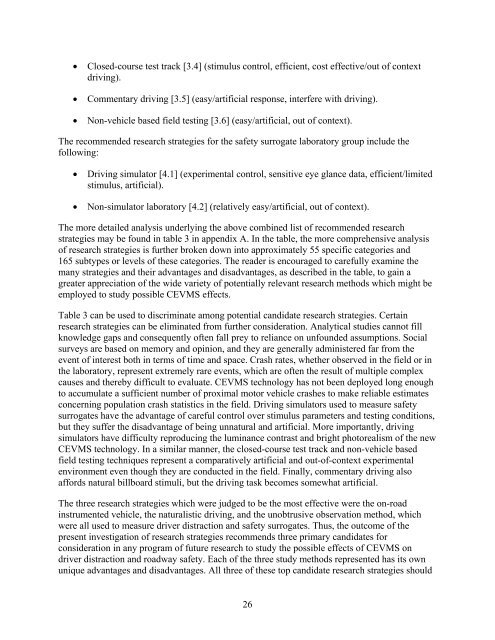The Effects of Commercial Electronic Variable Message Signs ...
The Effects of Commercial Electronic Variable Message Signs ...
The Effects of Commercial Electronic Variable Message Signs ...
Create successful ePaper yourself
Turn your PDF publications into a flip-book with our unique Google optimized e-Paper software.
• Closed-course test track [3.4] (stimulus control, efficient, cost effective/out <strong>of</strong> context<br />
driving).<br />
• Commentary driving [3.5] (easy/artificial response, interfere with driving).<br />
• Non-vehicle based field testing [3.6] (easy/artificial, out <strong>of</strong> context).<br />
<strong>The</strong> recommended research strategies for the safety surrogate laboratory group include the<br />
following:<br />
• Driving simulator [4.1] (experimental control, sensitive eye glance data, efficient/limited<br />
stimulus, artificial).<br />
• Non-simulator laboratory [4.2] (relatively easy/artificial, out <strong>of</strong> context).<br />
<strong>The</strong> more detailed analysis underlying the above combined list <strong>of</strong> recommended research<br />
strategies may be found in table 3 in appendix A. In the table, the more comprehensive analysis<br />
<strong>of</strong> research strategies is further broken down into approximately 55 specific categories and<br />
165 subtypes or levels <strong>of</strong> these categories. <strong>The</strong> reader is encouraged to carefully examine the<br />
many strategies and their advantages and disadvantages, as described in the table, to gain a<br />
greater appreciation <strong>of</strong> the wide variety <strong>of</strong> potentially relevant research methods which might be<br />
employed to study possible CEVMS effects.<br />
Table 3 can be used to discriminate among potential candidate research strategies. Certain<br />
research strategies can be eliminated from further consideration. Analytical studies cannot fill<br />
knowledge gaps and consequently <strong>of</strong>ten fall prey to reliance on unfounded assumptions. Social<br />
surveys are based on memory and opinion, and they are generally administered far from the<br />
event <strong>of</strong> interest both in terms <strong>of</strong> time and space. Crash rates, whether observed in the field or in<br />
the laboratory, represent extremely rare events, which are <strong>of</strong>ten the result <strong>of</strong> multiple complex<br />
causes and thereby difficult to evaluate. CEVMS technology has not been deployed long enough<br />
to accumulate a sufficient number <strong>of</strong> proximal motor vehicle crashes to make reliable estimates<br />
concerning population crash statistics in the field. Driving simulators used to measure safety<br />
surrogates have the advantage <strong>of</strong> careful control over stimulus parameters and testing conditions,<br />
but they suffer the disadvantage <strong>of</strong> being unnatural and artificial. More importantly, driving<br />
simulators have difficulty reproducing the luminance contrast and bright photorealism <strong>of</strong> the new<br />
CEVMS technology. In a similar manner, the closed-course test track and non-vehicle based<br />
field testing techniques represent a comparatively artificial and out-<strong>of</strong>-context experimental<br />
environment even though they are conducted in the field. Finally, commentary driving also<br />
affords natural billboard stimuli, but the driving task becomes somewhat artificial.<br />
<strong>The</strong> three research strategies which were judged to be the most effective were the on-road<br />
instrumented vehicle, the naturalistic driving, and the unobtrusive observation method, which<br />
were all used to measure driver distraction and safety surrogates. Thus, the outcome <strong>of</strong> the<br />
present investigation <strong>of</strong> research strategies recommends three primary candidates for<br />
consideration in any program <strong>of</strong> future research to study the possible effects <strong>of</strong> CEVMS on<br />
driver distraction and roadway safety. Each <strong>of</strong> the three study methods represented has its own<br />
unique advantages and disadvantages. All three <strong>of</strong> these top candidate research strategies should<br />
26

















